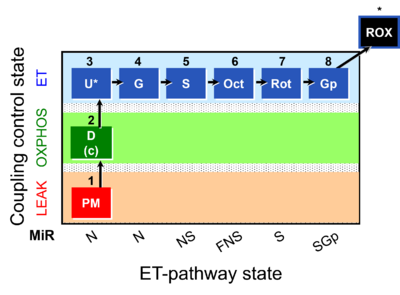Template:SUIT-001: Difference between revisions
No edit summary |
No edit summary |
||
| Line 24: | Line 24: | ||
| PM<sub>''P''</sub> or PM_P: N-OXPHOS capacity, N<sub>''P''</sub> | | PM<sub>''P''</sub> or PM_P: N-OXPHOS capacity, N<sub>''P''</sub> | ||
OXPHOS | {{Template:SUIT N}} {{Template:SUIT OXPHOS}} | ||
|- | |- | ||
| Line 33: | Line 33: | ||
| PMc<sub>''P''</sub> or PMc_P: Cytochrome c test for quality control | | PMc<sub>''P''</sub> or PMc_P: Cytochrome c test for quality control | ||
{{Template:SUIT N}} {{Template:SUIT OXPHOS}} {{Template:SUIT c}} | |||
|- | |- | ||
| Line 42: | Line 42: | ||
| PM<sub>''E''</sub> or PM_E: N-ET capacity, N<sub>''E''</sub> | | PM<sub>''E''</sub> or PM_E: N-ET capacity, N<sub>''E''</sub> | ||
{{Template:SUIT N}} {{Template:SUIT U*}} | |||
|- | |- | ||
| Line 49: | Line 49: | ||
| [[N]] | | [[N]] | ||
| CI | | CI | ||
| PGM<sub>''E''</sub> or PGM_E: N-ET capacity, N<sub>''E''</sub> | |||
{{Template:SUIT N}} {{Template:SUIT ET}} | |||
|- | |- | ||
| Line 55: | Line 58: | ||
| [[NS]] | | [[NS]] | ||
| CI&II | | CI&II | ||
| GMS<sub>'' | | GMS<sub>''E''</sub> or GMS_E: NS-OXPHOS capacity, NS<sub>''E''</sub> | ||
{{Template:SUIT N}} & {{Template:SUIT S}} {{Template:SUIT NS}} {{Template:SUIT ET}} | |||
|- | |- | ||
| 6Oct | | 6Oct | ||
| [[OctPGMS]] | | [[OctPGMS]]<sub>''E''</sub> | ||
| [[FNS]] | | [[FNS]] | ||
| FAO&CI&II | | FAO&CI&II | ||
| OctGMS<sub>''P''</sub> or GMS_P: NS-OXPHOS capacity, NS<sub>''P''</sub> | |||
{{Template:SUIT FNS}} {{Template:SUIT ET}} | |||
|- | |- | ||
| Line 72: | Line 78: | ||
| S<sub>''E''</sub> or S_E: S-ET capacity | | S<sub>''E''</sub> or S_E: S-ET capacity | ||
{{Template:SUIT Rot}} {{Template:SUIT ET}} | |||
|- | |- | ||
| Line 79: | Line 85: | ||
| [[SGp]] | | [[SGp]] | ||
| CII&GpDH | | CII&GpDH | ||
| SGp<sub>''E''</sub> or SGp_E: SGp-ET capacity | |||
{{Template:SUIT SGp}} {{Template:SUIT ET}} | |||
|- | |- | ||
| Line 87: | Line 96: | ||
| ROX: residual oxygen consumption | | ROX: residual oxygen consumption | ||
{{Template:SUIT Ama}} | |||
|} | |} | ||
{{Template:SUIT CIV}} | {{Template:SUIT CIV}} | ||
Revision as of 14:08, 11 January 2019
| Step | Respiratory state | Pathway control | ET-Complex entry into Q-junction | Comment |
|---|---|---|---|---|
| 1PM | PML | N | CI | PML or PM_L: Pyruvate & Malate, N-LEAK respiration, NL
NADH-linked substrates (type N-pathway to Q). Template:SUIT L n |
| 2D | PMP | N | CI | PMP or PM_P: N-OXPHOS capacity, NP
NADH-linked substrates (type N-pathway to Q). OXPHOS capacity P (with saturating [ADP]), active OXPHOS state. |
| 2c | PMcP | N | CI | PMcP or PMc_P: Cytochrome c test for quality control
NADH-linked substrates (type N-pathway to Q). OXPHOS capacity P (with saturating [ADP]), active OXPHOS state. Addition of cytochrome c yields a test for integrity of the mtOM (cytochrome c control efficiency). Stimulation by added cytochrome c would indicate an injury of the mtOM and limitation of respiration in the preceding state without added c due to loss of cytochrome c. Typically, cytochrome c is added immediately after the earliest ADP-activation step (OXPHOS capacity P with saturating [ADP]). |
| 3U | PME | N | CI | PME or PM_E: N-ET capacity, NE
NADH-linked substrates (type N-pathway to Q). Uncoupler titration (avoiding inhibition by high uncoupler concentrations) to obtain electron transfer (ET) capacity E (noncoupled ET-state). Test for limitation of OXPHOS capacity P by the phosphorylation system (ANT, ATP synthase, phosphate transporter) relative to ET capacity E in mt-preparations: E-P control efficiency and E-L coupling efficiency. In living cells: E-R control efficiency and E-L coupling efficiency. |
| 4G | PGM(E) | N | CI | PGME or PGM_E: N-ET capacity, NE
NADH-linked substrates (type N-pathway to Q). Noncoupled electron transfer state, ET state, with ET capacity E. |
| 5S | PGMSE | NS | CI&II | GMSE or GMS_E: NS-OXPHOS capacity, NSE
NADH-linked substrates (type N-pathway to Q). & Succinate, S ( type S-pathway to Q). Respiratory stimulation by simultaneous action of type N substrates & succinate, with convergent electron flow in the NS-pathway for reconstitution of TCA cycle function. Noncoupled electron transfer state, ET state, with ET capacity E. |
| 6Oct | OctPGMSE | FNS | FAO&CI&II | OctGMSP or GMS_P: NS-OXPHOS capacity, NSP
Respiratory stimulation by simultaneous action of the F-pathway, N-pathway, and S-pathway, with convergent electron flow in the FNS-pathway for reconstitution of TCA cycle function and additive or inhibitory effect of F. Noncoupled electron transfer state, ET state, with ET capacity E. |
| 7Rot | SE | S | CII | SE or S_E: S-ET capacity
Succinate pathway control state (S-pathway) after inhibiting CI with rotenone, which also inhibits the F-pathway. Noncoupled electron transfer state, ET state, with ET capacity E. |
| 8Gp | SGp(E) | SGp | CII&GpDH | SGpE or SGp_E: SGp-ET capacity
Respiratory stimulation by action of succinate and glycerophosphate, Gp, with convergent electron flow in the SGp-pathway (CII&GpDH-linked pathway to the Q-junction). Noncoupled electron transfer state, ET state, with ET capacity E. |
| 9Ama | ROX | ROX: residual oxygen consumption
Rox is the residual oxygen consumption in the ROX state, due to oxidative side reactions, estimated after addition of antimycin A (inhibitor of CIII). Rox is subtracted from oxygen flux as a baseline for all respiratory states, to obtain mitochondrial respiration (mt). |
| Step | Respiratory state | Pathway control | ET-Complex | Comment |
|---|---|---|---|---|
| ## AsTm | AsTmE | CIV | CIV | |
| ## Azd | CHB |
